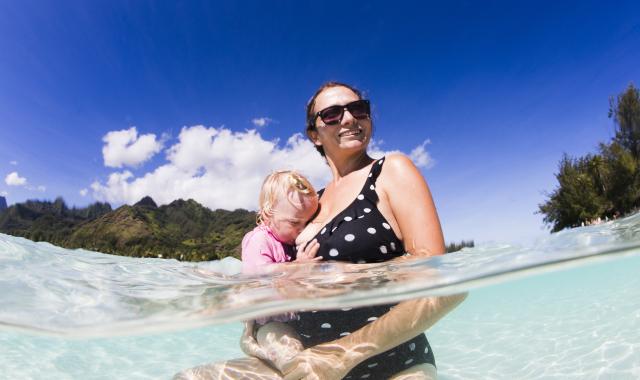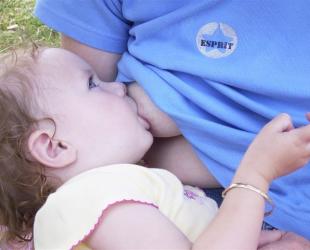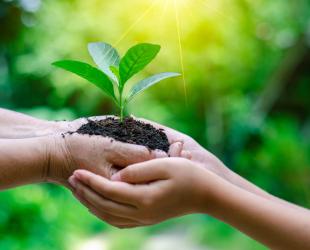Nearly all Australian mums start out breastfeeding but what happens after that?

The World Health Organization recommends exclusive breastfeeding for babies to 6 months of age and from then for breastfeeding to continue alongside suitable complementary foods for up to 2 years and beyond.
Exclusive breastfeeding means that the baby receives only breastmilk. No additional food or drink are given, not even water.
The National Health and Medical Research Council recommends exclusive breastfeeding for around 6 months and then for breastfeeding to continue alongside complementary food until 12 months of age and beyond, for as long as the mother and child desire.
Breastfeeding rates in Australia
Australian breastfeeding statistics show we are falling well short of the above recommendations.
Most Australian mothers want to breastfeed. Results from the 2010 Australian National Infant Feeding Survey (the latest research we have) shows that 96% of mothers start breastfeeding. However, there is a rapid fall in breastfeeding rates in the early weeks.
-
By around 3 months (less than 4 months) only 39% of babies are still being exclusively breastfed
-
By around 5 months (less than 6 months) only 15% are being exclusively breastfed. This tells us that most parents have introduced solids before 6 months.
Looking at non-exclusive breastfeeding:
-
69% of babies are receiving some breastmilk at 4 months of age
-
60% of babies are receiving some at 6 months
-
28% of babies are still breastfeeding at 12 months
-
Only 5% reached 2 years of breastfeeding.
Breastfeeding rates in indigenous communities
The 2014-15 National Aboriginal and Torres Strait Islander Social Survey (NATSISS) found that:
-
80% of Aboriginal and Torres Strait Islander children aged 0–3 years had been breastfed (received some breastmilk) in both non-remote (79%) and remote (87%) areas. Rates of breastfeeding in indigenous babies have stayed fairly constant since 2002.
However, breastfeeding rates drop more severely than for non-indigenous infants. The survey found that:
-
15% of indigenous babies had been weaned by 1 month.
-
By around 3 months (less than 4 months) only 19% of indigenous babies are exclusively breastfed.
-
By 6 months, only 7% are exclusively breastfed.
-
By 12 months, only 4% are still receiving breastmilk.
Some positive findings from the NATSIS survey included:
-
Indigenous rates of breastfeeding in the Northern Territory (98%) are much higher than in Victoria which had the lowest rates of any state (75%).
-
The Northern Territory has higher rates of breastfeeding for indigenous babies (98%) than for non-indigenous (81%).
-
Indigenous babies in remote areas (91%) are more likely to be breastfed than those in major cities (73%).
Breastfeeding rates in culturally and linguistically diverse (CALD) groups
Breastfeeding rates vary between different cultures in Australia. Cultures that have had a strong tradition in breastfeeding are now experiencing lower breastfeeding rates. According to the Australian National Infant Feeding Survey 2010, breastfeeding initiation rates of mothers born overseas were similar to Australian-born mothers. However at 1 month of age, exclusive breastfeeding rates had dropped to 58% compared with 62.5% for Australian-born mothers.
It is likely that migrant and refugee women may struggle to continue breastfeeding while managing life with a new infant in a new country. Some new mothers lack family support while others find the support offered by family members leads to conflict and tension, increasing the likelihood that the new mother will cease breastfeeding. Migrant women who value, but don't have access to, traditional postpartum practices are more likely to cease breastfeeding.
Other at-risk groups
The 2010 survey revealed the following population groups that are less likely to breastfeed are mothers who:
-
are young
-
are disadvantaged
-
have lower education levels
-
are daily smokers
-
had pre-pregnancy obesity.
© Australian Breastfeeding Association May 2022
World Health Organization statement 2011, Exclusive breastfeeding for six months best for babies everywhere, Geneva: World Health Organization. https://www.who.int/news/item/15-01-2011-exclusive-breastfeeding-for-six-months-best-for-babies-everywhere
National Health and Medical Research Council 2012, Infant Feeding Guidelines, Canberra: National Health and Medical Research Council www.eatforhealth.gov.au
Australian Institute of Health and Welfare 2011, 2010 Australian National Infant Feeding Survey: Indicator Results. Canberra: AIHW. http://www.aihw.gov.au/publication-detail/?id=10737420927
Australian Institute of Family Studies (AIFS) 2008, Growing Up In Australia: The Longitudinal Study of Australian Children, Annual Report 2006-07; www.aifs.gov.au/growingup/pubs/ar/ar200607/breastfeeding
National Aboriginal and Torres Strait Islander Social Survey, 2014-15
www.abs.gov.au/ausstats/abs@.nsf/mf/4714.0


